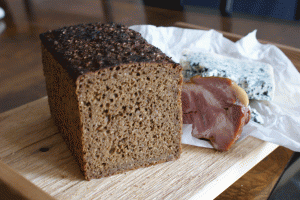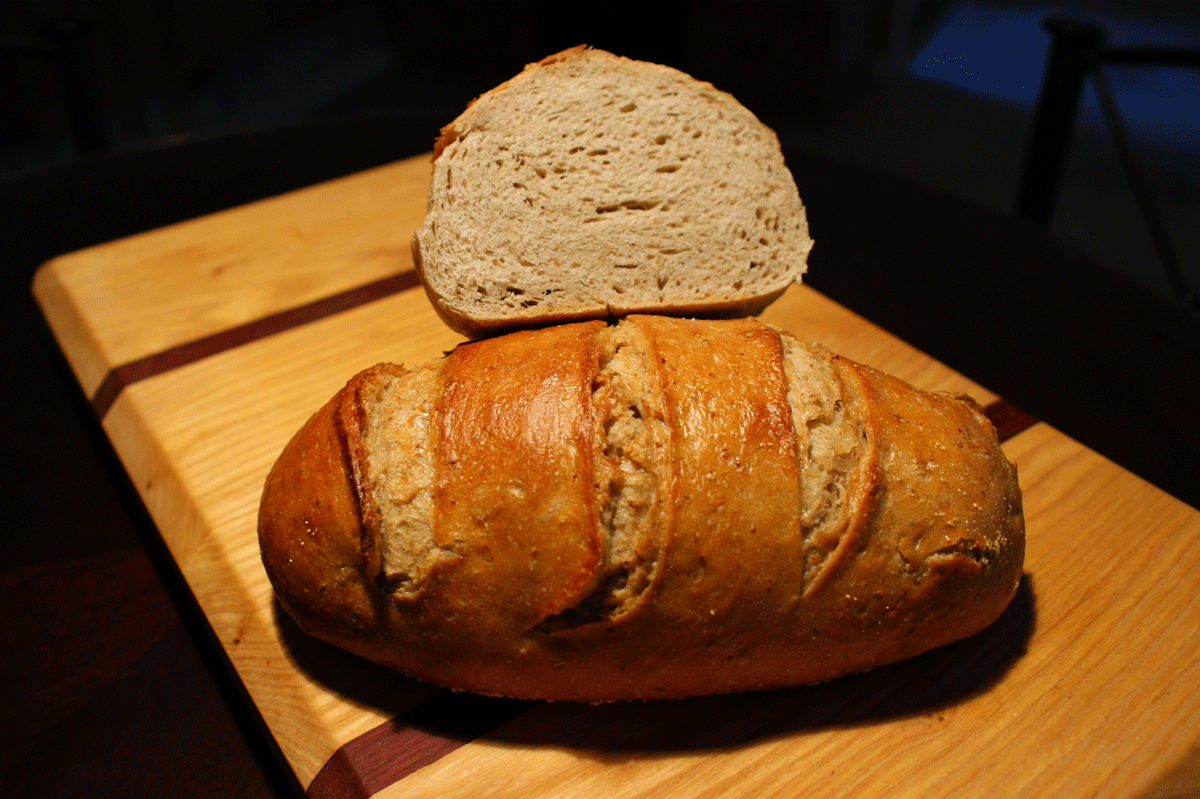I grew up eating rye bread — or at least what I thought of as rye bread — as the grandchild of eastern European Jewish immigrants. However, I didn’t start baking with rye until I began exploring my culinary roots, an exploration that ultimately came to fruition in Inside the Jewish Bakery.
During my research, I encountered the dense, dark rye breads that my grandparents’ generation subsisted on, but which had already disappeared from the Jewish bakeries of my childhood. I was hooked: My quest led me to the rye breads of northern, central and eastern Europe — largely unknown in the U.S. — where I found flavors, textures and baking challenges I never imagined existed.
 The world of rye is vast and, to most American bread lovers, entirely unknown. Rye fed most of Europe north of the Alps and eastward into Russia. It sustained Chaucer’s England, Villon’s Paris and the empires of Charlemagne and Peter the Great. When the rye crop failed — as it did on a massive scale during the 14th century — people starved and empires fell.
The world of rye is vast and, to most American bread lovers, entirely unknown. Rye fed most of Europe north of the Alps and eastward into Russia. It sustained Chaucer’s England, Villon’s Paris and the empires of Charlemagne and Peter the Great. When the rye crop failed — as it did on a massive scale during the 14th century — people starved and empires fell.
Today, rye breads remain an important part of both diet and cultural heritage through most of northern, central, and eastern Europe — and even as far south as northern Italy, Portugal and Spain. In America, we are not so fortunate: our wheat- and corn-driven industrial food culture has largely relegated rye to ethnic enclaves and animal feed, and that’s a shame. For in so doing, we’ve deprived ourselves of flavors and experiences that are not only special in themselves, but that also forge a powerful bond with the food cultures of generations past.
Over the past several years, I’ve baked well over a hundred classic rye breads from all across Europe and America. As my experience and understanding grew, what began as an exploration turned into a love story: I can’t imagine having a cupboard devoid of a dense, rustic, immensely flavorful loaf of rye bread, let alone returning to my pre-rye baguette-and-boule days.
Rye has ignited in me a passion for baking of an intensity I never imagined. I want to communicate that passion — and hopefully ignite it in as many fellow bread-lovers as I can — by sharing rye’s idiosyncrasies, joys and challenges, not to mention lots of good recipes. Hence, this blog and my forthcoming book, The Rye Baker, to be published in September, 2016.
I invite you to join me as I continue this splendid journey.


Michiel Eldering
January 4, 2016Are you familiair with the book of Charel Scheele on Old World Breads. He has some interesting rexipes for rye breads. He was born in the Netherlands, had a bekery in Belgium and moved to Canada and the US. He lives in New Mexico now. I’m focussing on breads in the Netherlands where rye was the bread for the common people for years.
elagins
January 5, 2016Don’t know it but will certainly look into it. Thanks and welcome!
Sam Kargl
January 5, 2016Hello Stan!
I want to cordially congratulate you on the new blog. Looking forward to new inspirations.
lg SAM
Monica Ioo
January 5, 2016Thank you for writing about the rye bread;
I’m interested in this fascinating rye!
Carolyn Larsen
January 5, 2016Can’t wait for your new book, and looking forward to learning more on this blog.
Jo tB
January 5, 2016Good Luck with your new blog.
Living in Europe we have a much greater variety of breads available than the US, so I can remember the German rye sourdough bread with carraway seeds. Yummie.
I just recently started my own quest of making my own rye sourdough starter and hopefully onto baking my own rye bread with carraway seeds.
Charlene Murdock
January 5, 2016Pleased to know about this. We are using freshly ground locally grown rye in our baked goods for our community. Most recently Rye Shards. We love using rye.
Susan Lawrence
January 5, 2016I love Rye bread! I bake sourdough rye bread every week but it’s only half rye and half white. I’d love to learn how to bake a 100% Rye bread that wasn’t a hockey puck .
Stanley Ginsberg
January 5, 2016And so you shall!
Steve Carlson
January 5, 2016Interesting subject! Happy to see a blog on the merits of rye. Need tips on rye bread making and where to obtain quality flour as well. Thanks.
Stanley Ginsberg
January 5, 2016The “where” part is easy. The New York Bakers (www.nybakers.com), which I own and operate, has the largest assortment of rye flours on the web. As for the tips, stay tuned; you’ll see a lot of recipes and other good rye baking information right here.
Muriel Harris
January 5, 2016Flour is a super-important ingredient, right? If so, what brands of rye flours do you use?
Stanley Ginsberg
January 5, 2016I prefer Bay State Milling’s flours, since they offer both quality and the widest variety of grinds and types. I also use General Mills white rye and medium rye. I’m very happy with the results both millers’ flours produce.
Ann Seeton
January 5, 2016Do you have plans for a link so I can “follow” this blog?
Stanley Ginsberg
January 5, 2016I do, but will have to figure out how to do it, since I’m a blogging novice. Anyone with suggestions? I’m using WordPress.
Muriel Harris
January 6, 2016Yup, there is a way to have people subscribe to a blog so that they get emails when there’s a new entry in the blog. I have subscribed to another blog so that I get notices when there’s a new post, but my email address is not public on the blog. I have now exhausted my entire knowledge of blogs.
Paul
January 25, 2016Hi Stan,
For a subscription link, your easiest route is to make sure you have the Jetpack plug in installed (it also offers a ton of other goodies). It’s part of the WordPress system and might already be active but if you don’t see it in your Plugins list, be sure to add it.
Once that’s been added and activated, you go under “Appearance” in your Dashboard and, under that, “Widgets”. One of your available widgets should be “Blog Subscriptions (Jetpack)” – click “Add”.
You’ll then be able to edit the subscription link’s title and other attributes, like placement, etc..
Presto bango, you’ve got a subscription link.
I’ll await your setting up that subscription link and then… I’ll subscribe!
Stanley Ginsberg
January 25, 2016Thanks Paul. Jetpack is installed. Hopefully, it will work.
Paul
January 26, 2016I see a Subscription link above! Woohoo! 😀
Subscribed!
Ginny D.
January 5, 2016Hi Stan,
Excited to see your new blog. Looking forward to learning more about rye bread and following your journey. I’m waiting patiently for your book release as one of your fellow Rye Gangsters.
Karin Anderson
January 6, 2016I’m glad that rye breads appear to catch on in the US – the total lack of them was the reason I started to bake my own after I came to Maine. Though I have to admit that I was never a fan of 100% ryes, I prefer mixed-flour breads.
Congratulations to your shiny new blog!
Karin
Stanley Ginsberg
January 6, 2016Thanks, Karin. You’ve been a real inspiration to me. The great thing about rye breads is that there are so many variations, from 100% ryes all the way down to 30% or so (beyond that, I’m not sure they qualify according to US tastes, with no DIN to guide us). I rejoice that they’re coming back and really want to spread the word.
Bill Middeke
January 8, 2016I’m looking forward to your book. I’ve always liked rye breads. I had a couple of devoted German grandparents in what was know as Little Germany in south St. Louis. Of course, to me as a kid, I didn’t know the difference and thought the caraway seeds in the bread was what made it rye. 🙂
Stanley Ginsberg
January 8, 2016Welcome, Bill. You’re not alone. A lot of what passes for rye bread today is mostly wheat with an oval cross-section and overwhelming caraway. Hopefully, the book — and this blod — will open a few minds to rye’s possibilities.
Irwin Mortman
January 9, 2016How do I Email a photo of my rye bread?
Stanley Ginsberg
January 10, 2016Honestly, I have no idea, other than for myself as the operator of the blog. I’ll look into it.
Barbara Troyer
January 10, 2016Rye bread has always sparked my interest because of the nutritional value. Then I discovered that I am diabetic ( low grade fortunately) and that rye bread does not spike my blood sugar………..every week I am baking my 71% rye bread with my own milled rye for myself and my farmers market customers. I just baked a pumpernickel (ginger&bread) which got high praise from somebody who grew up in Germany eating pumpernickel his grandmother baked. I am delighted to have found this blog and looking forward to learn more about this wonderful bread.
Barbara
Paul
January 25, 2016Hey again, Stan
I’m looking forward to your future posts. I have access to some locally grown and milled whole meal rye and want to make a good 60% rye loaf; I already have a 40% and 100%, but customers are looking for something in the middle.
They are also asking for pumpernickel but I can’t really see that long, 12-hour 250ºF bake fitting a bakery’s schedule when there’s always other things going into the deck ovens; there’s no way a few loaves of one bread can hold up one deck for themselves for that long.
If we were to produce a pumpernickel, we’d need to do the shortcut version with colouring and that makes me think it’s not really worth doing since that defeats the point.
What are your thoughts on this?
Stanley Ginsberg
January 25, 2016Your post has inspired me to do a 60% rye (plus or minus) for my next recipe post …. probably this weekend. Keep your eyes peeled.
As for pumpernickel and its 24-hour bake, you need to think of it as a steamed rye bread, of which there are many, and most with bake times of 12 hours or less, which could be manageable during your baking downtime. One of the easiest and fastest is Boston Brown Bread (if you don’t mind a lot of molasses), which only takes 3 hours or so. There’s also a very sour Finnish bread that bakes at low temperature for 4 hours, but that recipe will be in my book, so I’m hesitant to post it here. I’m also sitting on an Icelandic steamed rye that bakes for 6-8 hours, which I may also post in the next few weeks ….
Paul
January 26, 2016Excellent! I look forward to it.
Thanks Stan!
Elizabeth
June 15, 2021What is the name of the bread that is pictured on this page (the first and main picture)? This looks exactly like the rye bread my dad used to buy when I was a little girl – a family favourite!…
Stanley Ginsberg
June 15, 2021That’s an Old School Jewish Deli Rye